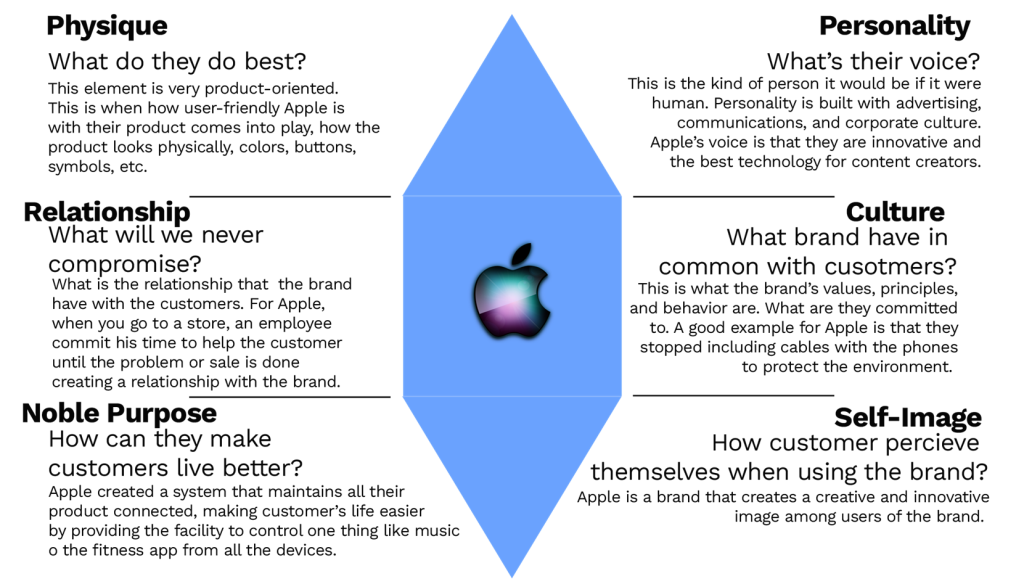Have you been to stores or places where they offer the same products, but when you experience them, they feel different? A good example is the difference between Target and Walmart or two universities like FIU and UM, both in Miami. Still, both are entirely different regarding how it feels to go to each campus and experience it. Those feelings and thoughts of the place are the effect of the brand. A brand is not only a color, font, or logo. A brand is about how a company’s distinctive features define themselves, such as name, design, symbols, terms, values, crowd, and others, and it should have a purpose. Based on the American Marketing Association, a brand is an approach companies use to promote and establish a brand in a market by creating a unique identity, values, and perceptions that differentiate it from competitors. Also, it is essential to understand that a brand is not what a marketer says but what the customer thinks and feels. Like a person, a brand has a personality and cultivates relationships that live in the customer’s perception and experience since they believe in those aspects more than advertising. In other words, a brand has dimensions that differentiate it from other products designed to satisfy some needs.
Creating a strong brand for a company is extremely important since this accelerates the growth of the business. It is more important than sales and more effective for the company’s growth in the long run. A good example is Apple, which keeps creating computers and cell phones yearly. At the same time, the technological advances mostly stay the same, and people keep paying thousands of dollars annually for the latest iPhone or Mac computer. What does Apple offer that other brands don’t, other than how user-friendly their products are? It offers status, quality (in the eyes of frequent buyers), luxury, and more. Apple has built a strong brand that created a standard in the industry, positioning itself as a luxury brand and a leader.
The elements around the brand must be defined to build a strong one. These areas are Physique, personality, relationship, culture, noble purpose, and self-image. Often, marketers explain this as the “Brand Identity Prism.” In the following image, I provide an example of this prism based on the Apple brand.

A process must be followed to create this prism for a strategic brand. This will help define how you want your customers to look at your brand and make the idea by providing a perspective. After that, it should create the customer’s feelings and perspectives about the brand.
1. Identify and establish brand positioning and values: for this step, marketers can create mental maps, define the core values of the brand, check who the competition is, and use them as a frame of reference (what can the brand do better compare with competitors), etc.
2. Plan and implement a brand marketing program: define the mix and match of brand elements that your brand will consist of—also, marketing activities such as campaigns, photos, graphic arts, websites, etc.
3. Measure and Manage Brand Performance: starting to evaluate the brand value chain, brand equity management, etc.
4. Grow and sustain brand equity: what are strategies for the brand to grow, and how has that growth impacted the brand expansion?

As a programmatic trader, before launching any digital campaign, it’s essential to understand the client’s brand so that they are aligned when creating the strategy, tactics, and audiences to target. Understanding the brand and its customers’ perspective will build the prospecting strategies around those specifics to bring new people with the same values, lifestyle, desires, etc., and turn them into a new customer. By creating the correct targeting based on the brand’s profile, the campaign will drive positive KPIs, and new customers are more likely to return to buying products from the brand more than once. For example, everyone knows the type of brand it is Apple. They are strong in their product design, music, podcast games, and other experiences in a very user-friendly device that will give you everything you need in the same system, including a watch and computer. With this small overview and the prism above, marketers should start creating a strategic approach for digital campaigns. Usually, Apple doesn’t run that much-paid media besides billboards and videos. Or unless they are launching a new product. When they came out with the ad for Apple Visions, they showed everything the brand is. One device that provides multiple experiences in the best or easiest way possible. Apple’s strategy when running ads is to show the product. They communicated in this order why Apple does what they do (what are its beliefs – they believe in challenging the status quo, they believe in thinking differently…), how it does what it does? (it makes its products beautifully designed and simple to use and user friendly), and what they do (they make computers). These new products it is not based on computers only, but they use a similar approach. They went viral, and they only had a video that was in paid media so far. This strategy has been working for years for them, creating customers who will be loyal to and embrace the brand. This has created what apple is right now as a company and a brand.
A strong brand will create returning customers, turning them into loyal buyers. That’s one way to know how the brand is performing in terms of being strong.
I’ve seen marketers that believe that some products are not marketable. I believe that every product can be sold. Each person is their universe, and that’s what makes them unique. A product will always be in someone’s mind and heart; a brand must find it. With technology nowadays, you can target people by behavior, interests, websites, and more. With a good investment and strategy, brands can find those future clients.






Leave a Reply